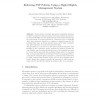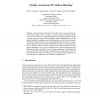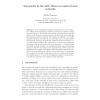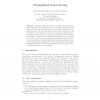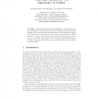100
click to vote
PET
2007
Springer
15 years 7 months ago
2007
Springer
Abstract. Location privacy is of utmost concern for location-based services. It is the property that a person’s location is revealed to other entities, such as a service provider...
102
click to vote
PET
2007
Springer
15 years 7 months ago
2007
Springer
We introduce a new traffic analysis attack: the Two-sided Statistical Disclosure Attack, that tries to uncover the receivers of messages sent through an anonymizing network support...
108
Voted
PET
2007
Springer
15 years 7 months ago
2007
Springer
The protection of privacy has gained considerable attention recently. In response to this, new privacy protection systems are being introduced. SITDRM is one such system that prote...
154
click to vote
PET
2007
Springer
15 years 7 months ago
2007
Springer
Abstract. Anonymizing networks such as Tor allow users to access Internet services privately using a series of routers to hide the client’s IP address from the server. Tor’s su...
110
click to vote
PET
2007
Springer
15 years 7 months ago
2007
Springer
Abstract. As decentralized computing scenarios get ever more popular, unstructured topologies are natural candidates to consider running mix networks upon. We consider mix network ...
105
click to vote
PET
2007
Springer
15 years 7 months ago
2007
Springer
Abstract. This paper presents a novel use of pairing-based cryptography to improve circuit construction in onion routing anonymity networks. Instead of iteratively and interactivel...
93
Voted
PET
2007
Springer
15 years 7 months ago
2007
Springer
Abstract. The Domain Name System (DNS) is the only globally deployed Internet service that provides user-friendly naming for Internet hosts. It was originally designed to return th...
PET
2007
Springer
15 years 7 months ago
2007
Springer
A system that protects the unlinkability of certain data items (e. g. identifiers of communication partners, messages, pseudonyms, transactions, votes) does not leak information t...
79
Voted
PET
2007
Springer
15 years 7 months ago
2007
Springer
Neither of the two anonymisation services Tor and AN.ON clearly outperforms the other one. AN.ON’s user-perceived QoS is generally more consistent over time than Tor’s. While A...
PET
2007
Springer
15 years 7 months ago
2007
Springer

